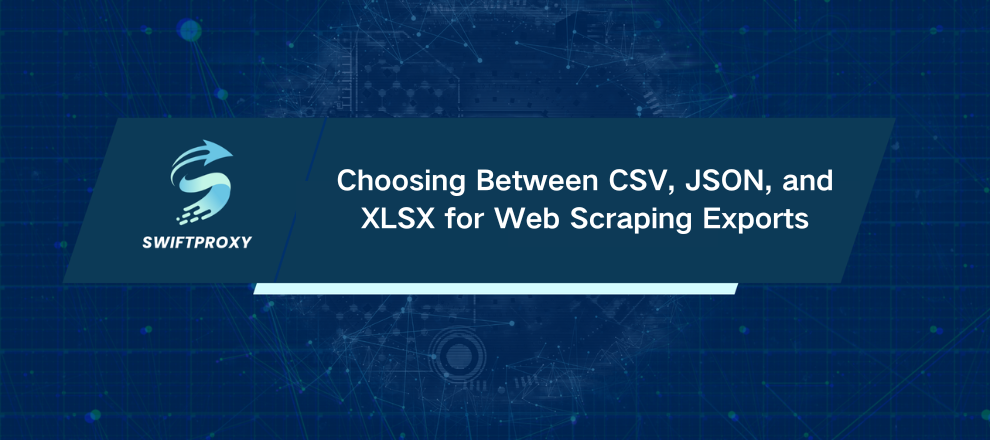Choosing Between CSV, JSON, and XLSX for Web Scraping Exports
When you pull a massive dataset from a website, you might quickly realize that the format can make or break your workflow. It’s frustrating when valuable data becomes hard to analyze, share, or integrate simply because of its file type. Whether you’re building dashboards, running analytics, or presenting insights to stakeholders, choosing between CSV, JSON, or XLSX isn’t just a technical detail—it’s a strategic decision. Let’s break down each format, what it excels at, and how to know which one fits your needs best.

Why File Format Matters
Data formats aren't just arbitrary choices—they determine usability, compatibility, and efficiency.
Compatibility is the first consideration. Standard formats like CSV, XLSX, and JSON are universally recognized. From Excel and Google Sheets to SQL databases and BI tools, these formats let data move seamlessly across systems. Without them, you risk time-consuming conversions and errors.
Automation is another game-changer. Consistent formats allow automated pipelines to function without hiccups. CSV and JSON, for instance, fit perfectly into repeatable processes—from nightly updates of spreadsheets to feeding machine learning models.
Then there's the human factor. Not everyone handling data is technical. XLSX, with its charts, filters, and formatting, ensures non-developers can extract insights without extra effort.
Finally, scalability matters. As datasets grow in volume and complexity, standardized formats maintain order and performance. JSON shines here, capable of handling deeply nested structures like product catalogs, hotel listings, or user reviews—all in one structured file.
JSON: Flexibility Meets Structure
JSON (JavaScript Object Notation) is lightweight, readable, and perfect for structured, hierarchical data. Originally from JavaScript, it's now language-agnostic and a staple in APIs and web scraping workflows.
Why JSON Works
Nested Structures: JSON can represent complex hierarchies. A hotel can have rooms, amenities, pricing, and availability—all organized logically.
Machine-Friendly: Nearly every programming language supports JSON, making it ideal for automated pipelines and integrations.
Lightweight: Without the overhead of XLSX formatting or repeated CSV headers, JSON is compact and efficient for storage and transfer.
Example:
{
"hotel_name": "Hotel Barcelona Center",
"location": "Barcelona, Spain",
"rooms": [
{"type": "Standard Single", "price": 142, "currency": "EUR", "available": true},
{"type": "Deluxe Double", "price": 198, "currency": "EUR", "available": false}
],
"rating": 4.3
}
Limitations
JSON isn't ideal for everyone. It can be intimidating for non-developers and isn't meant for visually-driven reports. Flattening nested JSON into a spreadsheet often requires extra steps. It's perfect for automation, not presentation.
CSV: Simple, Fast, Reliable
CSV (Comma-Separated Values) is plain text, yet remarkably powerful. It's the classic choice for flat, tabular datasets.
Why CSV Works
Simplicity: Easy to read and generate. Rows and columns, nothing more.
Compatibility: Works in Excel, Google Sheets, databases, and programming languages.
Lightweight: Fast to store and transfer, even in huge volumes.
Human-Readable: Anyone can open and edit a CSV in a text editor.
Example:
hotel_name,location,room_type,price,currency,available,rating
Hotel Barcelona Center,Barcelona, Spain,Standard Single,142,EUR,true,4.3
Hotel Barcelona Center,Barcelona, Spain,Deluxe Double,198,EUR,false,4.3
Limitations
CSV struggles with complex structures. No nesting, no formulas, no charts. Special characters like commas or line breaks can break parsing if not handled carefully. It's efficient for machines and humans alike—but only for straightforward tables.
XLSX: Presentation-Ready Power
XLSX is Excel's modern format, built for presentation and analysis. Beyond storing data, it helps users explore and understand it.
Why XLSX Works
Rich Formatting: Colors, conditional formatting, charts, and data validation.
Multiple Sheets: Organize complex datasets into tabs.
Formulas and Pivot Tables: Analyze data directly within Excel.
Collaboration-Friendly: Perfect for business teams and stakeholders.
Example:
| hotel_name | location | room_type | price | currency | available | rating |
|---|---|---|---|---|---|---|
| Hotel Barcelona Center | Barcelona, Spain | Standard Single | 142 | EUR | TRUE | 4.3 |
| Hotel Barcelona Center | Barcelona, Spain | Deluxe Double | 198 | EUR | FALSE | 4.3 |
Limitations
XLSX files are heavier, slower to process, and harder to automate than CSV or JSON. Nested structures require flattening, which can lose data hierarchy. Advanced features may not render in non-Excel environments.
When to Use Each Format
JSON: Use for hierarchical, structured data intended for automated pipelines, APIs, or backend systems. Ideal for developers.
CSV: Best for flat, tabular datasets. Quick to import/export, lightweight, and broadly compatible. Great for mixed teams and simple data analysis.
XLSX: Perfect when presentation, collaboration, or advanced analysis is critical. Ideal for reports, dashboards, and business reviews.
Conclusion
The power of web-scraped data comes to life when it's in the right format. CSV makes flat tables quick and easy to handle, JSON keeps complex, nested data structured and automation-ready, and XLSX turns numbers into clear, actionable insights. Choosing between CSV, JSON, and XLSX for web scraping exports ensures your data is not just collected, but ready to analyze, share, and drive informed decisions.





















































